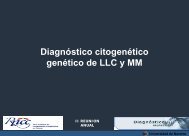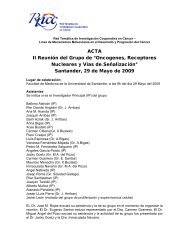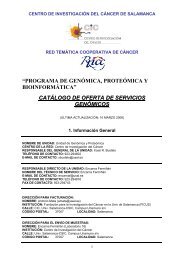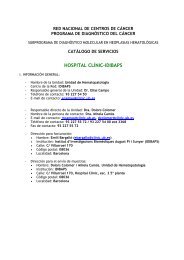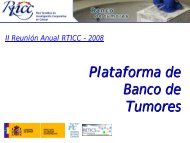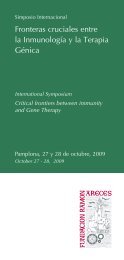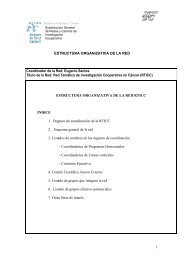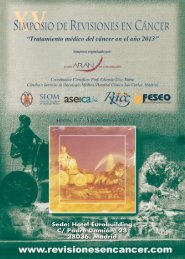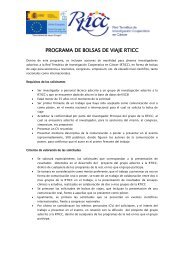Untitled - Red Temática de investigación cooperativa en cáncer
Untitled - Red Temática de investigación cooperativa en cáncer
Untitled - Red Temática de investigación cooperativa en cáncer
You also want an ePaper? Increase the reach of your titles
YUMPU automatically turns print PDFs into web optimized ePapers that Google loves.
O-12<br />
DIOXIN RECEPTOR CONTROLS CSK-BINDING PROTEIN SIGNALING TO CAVEOLIN 1<br />
AND Β1 INTEGRIN TO MODULATE CELL ADHESION AND MIGRATION<br />
REY-BARROSO J 1 , COLÓ GP 2 , ÁLVAREZ-BARRIENTOS A 1 , REDONDO-MUÑOZ J 2 , CARVAJAL-GONZÁ-<br />
LEZ JM 3 , MULERO-NAVARRO S 3 , GARCÍA-PARDO A 2 , TEIXIDÓ J 2 ,FERNÁNDEZ-SALGUERO PM 1<br />
1<br />
UNIVERSIDAD DE EXTREMADURA, BADAJOZ (RD06/0020/1016)<br />
2<br />
CENTRO DE INVESTIGACIONES BIOLÓGICAS (CIB), MADRID (RD06/0020/0011)<br />
3<br />
MOUNT SINAI SCHOOL OF MEDICINE<br />
O-13<br />
CD44 POSITIVITY CONFERS RESISTANCE TO SORAFENIB-INDUCED CELL DEATH IN<br />
HEPATOCELLULAR CARCINOMA (HCC) CELLS<br />
FERNANDO J 1 , ÁLVAREZ-BARRIENTOS A 2 , FERNÁNDEZ-SALGUERO PM 2 , CEPEDA EB 1 , FERNÁNDEZ-<br />
RODRIGUEZ CM 3 , SANCHO P 1 , FABREGAT I 1<br />
1<br />
IDIBELL, BARCELONA (RD06/0020/0097)<br />
2<br />
UNIVERSIDAD DE EXTREMADURA BADAJOZ (RD06/0020/1016)<br />
3<br />
HOSPITAL UNIVERSITARIO FUNDACIÓN ALCORCÓN, MADRID<br />
Rec<strong>en</strong>t studies strongly support a regulatory role for the dioxin receptor (AhR) in cell adhesion<br />
and migration.<br />
Following our previous work, we report here that the C-terminal Src kinase-binding protein<br />
(Cbp)-Csk-Src pathway sustains migration of transformed fibroblasts (T-FGM) and regulates<br />
β1 integrin activation andcaveolin-1 (Cav1) tyrosine phosphorylation, and that such<br />
mechanism is AhR <strong>de</strong>p<strong>en</strong><strong>de</strong>nt. T-FGM AhR-/-fibroblasts had higher integrin β1 activation<br />
that coinci<strong>de</strong>d with higher Cbp expression, increased fibronectin secretion and impaired<br />
directional migration.<br />
Notably, interfering Cbp/Pag1 expression in AhR-/- fibroblasts rescued β1 integrin activation,<br />
migration and cell morphology. c-Src activation (Tyr 416) was inhibited, probably<br />
because the increase in Cbp/Pag1 levels produced an accumulation of inhibitory Csk- Cbp/<br />
Pag1 complexes. Consist<strong>en</strong>tly, focal adhesion kinase (FAK) phosphorylation was reduced at<br />
Tyr 576 –Tyr 577.<br />
The c-Src target Cav1was hypophosphorylated at Tyr 14, and its association to c-Src diminished<br />
in AhR-/- cells. Interestingly, AhR was pres<strong>en</strong>t at the plasma membrane in <strong>de</strong>terg<strong>en</strong>t<br />
resistant microdomains (DRM; rafts) and co-immunoprecipitated with Cav1 un<strong>de</strong>r basal cell<br />
conditions, revealing a functional link by which AhR could alter Cav1 distribution betwe<strong>en</strong><br />
DRM and non-DRM domains.<br />
Furthermore, AhR interfer<strong>en</strong>ce impaired directional migration and Cav1distribution. Thus,<br />
fibroblasts migration requires AhR for proper regulation of the Cbp/Pag1-<strong>de</strong>p<strong>en</strong><strong>de</strong>nt signaling<br />
to β1 integrin and Cav1.<br />
As Hepatocellular carcinoma (HCC) is the fifth cause of cancer-associated mortality in the<br />
West and one of the leading worldwi<strong>de</strong> causes of <strong>de</strong>ath, exists an urge to <strong>de</strong>velop efficacious<br />
tumor-targeted ag<strong>en</strong>ts [1-4]. Exist<strong>en</strong>ce of Cancer Stem Cells (CSCs) or Tumor Initiating<br />
Cells (TICs) was proposed forty years ago, but they have only be<strong>en</strong> i<strong>de</strong>ntified rec<strong>en</strong>tly<br />
in liver cancers. These cells show a highly-effici<strong>en</strong>t self r<strong>en</strong>ewal, ability to differ<strong>en</strong>tiate into<br />
differ<strong>en</strong>t lineages, drug-resistance and tumor reg<strong>en</strong>erating capacity [5]. Their pres<strong>en</strong>ce<br />
might change therapeutic targeting, since effective approaches could overlook TICs elimination.<br />
In this work we have examined the expression of TIC markers, such as EpCAM,<br />
CD44 or CD90, in differ<strong>en</strong>t HCC cell lines to establish correlations, if they exist, with the<br />
responsiv<strong>en</strong>ess to the first line targeted therapeutic actual option for HCC, i.e., the multikinase<br />
inhibitor soraf<strong>en</strong>ib [6].<br />
Analysis of TICs-related markers allowed us to i<strong>de</strong>ntify a group of differ<strong>en</strong>t HCC cell lines<br />
that were EpCAM+/CD44- and another one that were EpCAM-/CD44+. Expression of CD44<br />
correlated with a more <strong>de</strong>-differ<strong>en</strong>tiated and invasive ph<strong>en</strong>otype . Interestingly, CD44+<br />
cells were much less responsive to soraf<strong>en</strong>ib in terms of cell <strong>de</strong>ath. Targeting knock-down<br />
of CD44 with specific siRNA s<strong>en</strong>sitized cells to this drug, indicating the direct role played by<br />
CD44 in conferring soraf<strong>en</strong>ib resistance. These results op<strong>en</strong> the possibility for a better fitness<br />
prediction to soraf<strong>en</strong>ib treatm<strong>en</strong>t and suggest a pot<strong>en</strong>tial targeting of CD44 combined<br />
with the use of soraf<strong>en</strong>ib as a strategy on CD44-positive pati<strong>en</strong>ts. Furthermore, we found<br />
that soraf<strong>en</strong>ib could be interfering in TIC markers pres<strong>en</strong>tation, as the inhibitor <strong>de</strong>creased<br />
the perc<strong>en</strong>tage of CD90+ cells, but simultaneously increased EpCAM expression in those<br />
cells that previously expressed it. Future experim<strong>en</strong>ts will reveal the relevance of these<br />
effects.<br />
Refer<strong>en</strong>ces:<br />
1. Andrisani, O.M., L. Studach, and P. Merle. Semin Cancer Biol. 21(1): p. 4-9.<br />
2. Worns, M.A. and P.R. Galle. Expert Opin Investig Drugs. 19(5): p. 615-29.<br />
3. Luo, J.H., et al. Hepatology. 44(4): p. 1012-24.<br />
4. Villanueva, A., et al. Annu Rev Med. 61: p. 317-28.<br />
5. Rountree, C.B., L. Mishra, and H. Will<strong>en</strong>bring. Hepatology. 55(1): p. 298-306.<br />
6. Llovet, J.M., et al. N Engl J Med. 359(4): p. 378-90.<br />
We acknowledge Ministerio <strong>de</strong> Economía y Competitividad, Spain, AGAUR-G<strong>en</strong>eralitat <strong>de</strong><br />
Catalunya and IDIBELL for providing research funds and also the <strong>Red</strong> Temática <strong>de</strong> Investigación<br />
Cooperativa <strong>en</strong> Cáncer, RTICC-ISCIII, for funding a mobility program that ma<strong>de</strong> this<br />
work possible. We are also <strong>de</strong>eply grateful to Bayer Schering Pharma AG (Berlin,Germany)<br />
for providing soraf<strong>en</strong>ib.<br />
28 29



